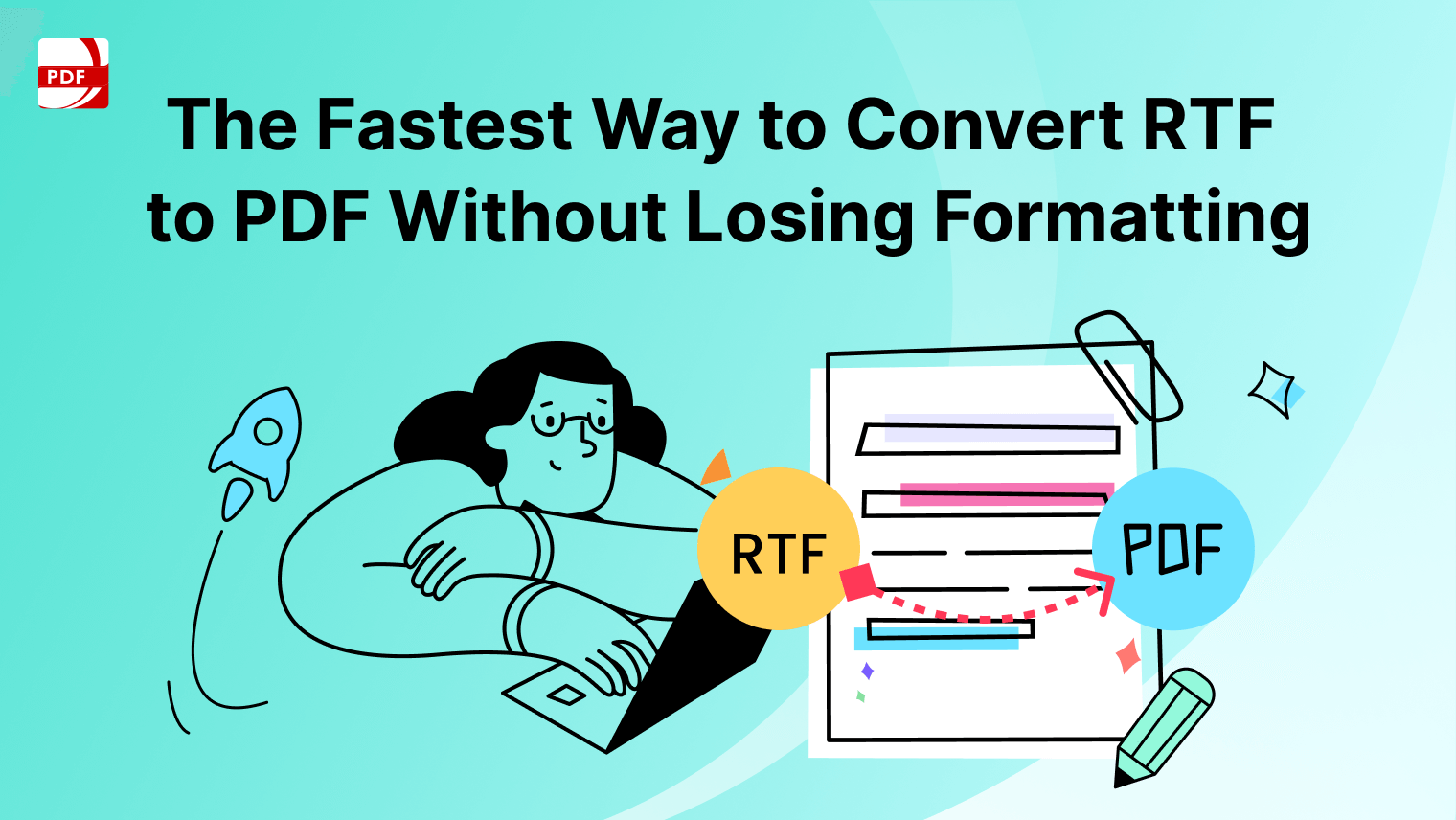Rich Text Format (RTF) balances rich formatting options and broad compatibility across various applications and platforms.
In this guide, we'll explore the essentials of exporting to RTF format, including understanding an RTF file, best practices for a seamless export, and addressing common questions to help you with PDF Reader Pro's PDF conversion magic.
How to Export to RTF Format on Windows
Easily export your original document from a different file type to RTF format with PDF Reader Pro's conversion capabilities on your Windows operating system.
Step 1: Open Your PDF Document
Drag and drop your document from your list of files or click "Open File".
Image Source: PDF Reader Pro
Step 2: Click "Converter" on the Menu
Start the conversion process with our built-in tools. 
Image Source: PDF Reader Pro
Step 3: Click "PDF to Others"
Select "RTF" as your conversion export format. Our tools allow you quicker conversion with handy shortcut buttons.
Image Source: PDF Reader Pro
Step 4: Adjust Export Options on Dialog Window
Click "Convert" to save to your destination folder. Here you can change your document title and choose a custom folder. 
Image Source: PDF Reader Pro
How to Export to RTF Format on Mac
Change your original document from its current file type to RTF format using PDF Reader Pro on your Mac operating system.
Step 1: Open Your Original PDF File
Drag and drop from your file explorer or click "Open File".
Image Source: PDF Reader Pro
Step 2: Click "Converter" on the Toolbar
Use our converter tool to start the process.
Image Source: PDF Reader Pro
Step 3: Choose RTF as Your Export Format
Begin format conversion to your preferred file format. 
Image Source: PDF Reader Pro
Step 4: Adjust Your Page Selection
Click "Convert" to export to your output folder and add a document title. 
Image Source: PDF Reader Pro
What is an RTF File?
RTF, which stands for Rich Text Format, is a document file format developed by Microsoft. It serves as a cross-platform document format that encapsulates rich text and basic formatting elements. Unlike some proprietary formats, RTF is open, making it accessible to a wide range of software applications.
Key characteristics of RTF files include:
-
Rich Text: RTF supports various text attributes, such as font styles, sizes, colors, and alignments. It also allows you to embed images, tables, and hyperlinks within the text.
-
Compatibility: RTF is compatible with many word processing applications, both on Windows and macOS platforms. This compatibility makes it an excellent choice for sharing documents across different systems.
-
Plain Text Core: Despite its rich formatting capabilities, RTF files essentially consist of plain text with embedded control codes. This structure makes it easy to read and edit with a simple text editor.
"PDF Reader Pro has been a game-changer for document accessibility, offering solutions that make inclusivity a norm in document sharing." Theodore CipollaB2B SaaS Content MarketerSource: LinkedIn
Theodore CipollaB2B SaaS Content MarketerSource: LinkedIn
You can also check our article resource for more information on How to Export Figma to PDF.
Best Practices for Exporting to RTF
To ensure a smooth and effective export to RTF format, consider the following best practices:
1. Choose the Right Software: Use a word processing or document editing software that supports RTF export. Popular choices include Microsoft Word, LibreOffice, and Google Docs.
2. Maintain Formatting: Before exporting, review the document for formatting consistency. Ensure that fonts, styles, and special formatting (e.g., bold or italics) are applied uniformly.
3. Check Image Compatibility: If your document contains images, ensure that they are in a compatible format. RTF supports common image types like JPEG and PNG. Convert images to a supported format if necessary.
4. Hyperlinks and Bookmarks: If your document includes hyperlinks or bookmarks, verify that they remain functional after the export. RTF should maintain the links if the target application supports them.
5. Testing Across Platforms: After export, test the RTF document on various platforms and applications to verify that formatting and content remain intact.
6. Use File Compression: Consider compressing your RTF file using ZIP or similar compression formats if the document is large. This reduces file size and eases sharing and storage.
7. Accessibility Considerations: When exporting to RTF, ensure that the document remains accessible to all users, including those who rely on screen readers. Use descriptive text for images and proper headings for document structure.
8. Metadata Preservation: If your document contains metadata like author information, make sure it is preserved in the RTF file. Metadata can be vital for document management and information retrieval.
Export to RTF Format: FAQs
Have a question that we haven't answered about rich text documents? Peruse our FAQ section below for the answer:
Can I Open RTF Files on Any Operating System?
Yes, RTF export files are compatible with both Windows and macOS operating systems. Many popular word processing software, including Microsoft Word and LibreOffice, support RTF on various platforms.
Are RTF Files Secure?
RTF files are generally safe, but like any file format, they can potentially contain malicious content. Exercise caution when opening RTF files from untrusted sources, especially if they contain macros. Ensure you also use caution when using online services to edit single documents.
Can I Convert RTF Export Files to Other Formats?
Yes, you can convert RTF files to other formats using document conversion tools or word processing software. Common conversions from original file formatting include RTF to PDF, RTF to DOCX, and RTF to HTML.
Is RTF Suitable for Complex Layouts?
RTF is best suited for basic to moderately complex document layouts in original source documents. While it supports tables and images, highly intricate layouts may not be preserved as effectively.
Can I Edit RTF Files with a Text Editor?
Yes, RTF output files essentially consist of plain text, and you can edit the entire document with a text editor. However, for more advanced formatting and styles, it's better to use dedicated word processing software.
Does RTF Support Collaborative Editing?
RTF files are less suitable for real-time collaborative editing compared to cloud-based formats like Google Docs. However, some collaboration features can be supported depending on the software you use.
Can I Convert an RTF File to PDF?
Yes, you can easily convert an RTF file to PDF using our processing systems. Many word processing software, online converters, and dedicated PDF creation tools support RTF to PDF conversion.
Is RTF Compatible with Mobile Devices?
RTF files are compatible with mobile devices and can be opened using various apps and mobile versions of popular word processors. Ensure that you have a compatible app installed to access and edit RTF files on your mobile device.
What Are the Advantages of Using RTF Over DOCX or PDF?
RTF offers advantages such as cross-platform compatibility and a simpler file structure, making it a more lightweight option for basic document sharing. It's especially useful when the formatting needs to be preserved across different systems without the complexity of DOCX or the fixed layout of PDF.
Can RTF Files Contain Macros or Scripts?
RTF files can potentially contain macros or scripts, which can be a security concern. When opening RTF files, especially from unknown sources, be cautious of potential security risks and enable macro/script execution only from trusted and verified documents.
Exporting to RTF format provides a versatile and widely supported solution for sharing documents while maintaining rich text and formatting. By adhering to best practices and addressing common questions, you can navigate the export process with ease, ensuring your documents remain accessible and readable on different platforms and applications.









 Free Download
Free Download  Free Download
Free Download 





 Support Chat
Support Chat